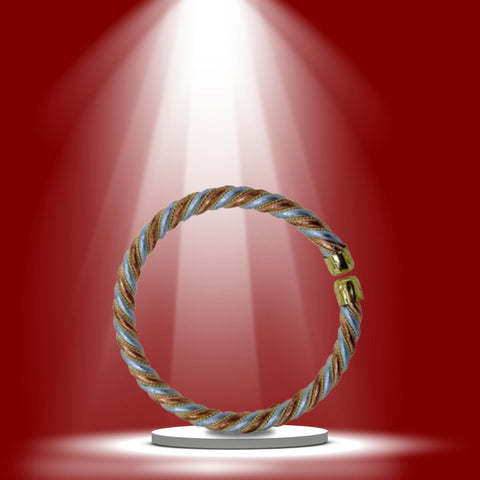The Ashtdhatu Kada, also known as the "eight-metal bangle," holds a significant position in Indian culture. It is a beautiful and versatile bracelet, traditionally crafted from a unique blend of eight metals, each with its own symbolic meaning and potential benefits. This article delves into the world of the Ashtdhatu Kada, exploring its history, significance, potential benefits, and the reasons why it continues to adorn the wrists of individuals across generations.

History Of Ashtdhatu Kada:
The origins of the Ashtdhatu Kada can be traced back centuries, with mentions found in ancient texts and artistic representations. The concept of combining different metals for their symbolic and purported benefits finds roots in the Ayurvedic system of medicine, which emphasizes the balance of energies within the body.
The Eight Metals and Their Importance:
The eight metals used in the creation of an Ashtdhatu Kada hold specific meanings and are believed to possess unique properties:
- Gold: Associated with prosperity, purity, and divine energy.
- Silver: Represents purity, peace, and calmness.
- Copper: Symbolic of healing, reducing inflammation, and promoting good health.
- Zinc: Believed to enhance immunity and strengthen the body's defenses.
- Lead: Traditionally associated with stability and grounding energies.
- Iron: Represents strength, determination, and overcoming challenges.
- Tin: Symbolic of flexibility, adaptability, and mental clarity.
- Mercury: Associated with communication, intelligence, and transformation.
It's important to note that the exact composition of the Ashtdhatu Kada may vary depending on the region, tradition, and jeweler. However, the essence remains the same - a unique blend of metals with symbolic and potential health benefits.
Benefits Of the Ashtdhatu Kada:
While the scientific validity of the specific benefits associated with the Ashtdhatu Kada remains inconclusive, it holds significant meaning within the context of faith, tradition, and cultural practices. Some of the potential benefits attributed to the Ashtdhatu Kada include:
- Promoting overall well-being: The combined properties of the individual metals are believed to contribute to improved health, increased energy levels, and a sense of balance.
- Balancing energies: According to Ayurvedic principles, the Ashtdhatu Kada can help balance the three doshas (Vata, Pitta, and Kapha) within the body, leading to improved physical and mental well-being.
- Attracting positive energy: The symbolic associations of the metals are seen as attracting positive energy, fostering good luck, and promoting success.
- Cultural Significance: The Ashtdhatu Kada holds cultural significance in various communities, often passed down through generations as a cherished heirloom. It serves as a symbol of tradition, family heritage, and cultural identity.
Why Do People Wear the Ashtdhatu Kada?
There are several reasons why individuals choose to wear the Ashtdhatu Kada:
- Faith and Tradition: For many, wearing the Ashtdhatu Kada is a way to connect with their faith and cultural traditions.
- Belief in Its Benefits: Some individuals are drawn to the potential health and well-being benefits associated with the bracelet.
- Aesthetic Appeal: The Ashtdhatu Kada can be a beautiful and versatile accessory, adding a touch of elegance and cultural significance to any outfit.
- Sentimental Value: The Ashtdhatu Kada, often passed down through generations, can hold significant sentimental value, serving as a cherished reminder of loved ones and family history.
Considerations and Precautions:
While the Ashtdhatu Kada is generally considered safe for most individuals, it is crucial to be mindful of a few things:
- Metal Allergies: Individuals with known allergies to any of the metals used in the Ashtdhatu Kada should avoid wearing it to prevent skin irritation or allergic reactions.
- Sourcing and Quality: It is essential to purchase the Ashtdhatu Kada from reputable sources that use high-quality materials and ensure safe manufacturing practices.
- Scientific Evidence: It is important to remember that the attributed benefits of the Ashtdhatu Kada primarily stem from faith and tradition. There is limited scientific evidence to support these claims, and the bracelet should not be seen as a substitute for professional medical advice or treatment.